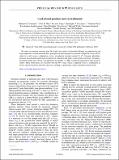| dc.contributor.author | Ciccarino, Christopher J. | |
| dc.contributor.author | Flick, Johannes | |
| dc.contributor.author | Sundararaman, Ravishankar | |
| dc.contributor.author | Malladi, Girish | |
| dc.contributor.author | Walsh, Michael | |
| dc.contributor.author | Bakhru, Hassaram | |
| dc.contributor.author | Narang, Prineha | |
| dc.contributor.author | Trusheim, Matthew E | |
| dc.contributor.author | Wan, Noel Heng Loon | |
| dc.contributor.author | Chen, Kevin C. | |
| dc.contributor.author | Bersin, Eric Alexander | |
| dc.contributor.author | Lienhard, Benjamin | |
| dc.contributor.author | Englund, Dirk R. | |
| dc.date.accessioned | 2019-03-26T13:56:02Z | |
| dc.date.available | 2019-03-26T13:56:02Z | |
| dc.date.issued | 2019-02 | |
| dc.date.submitted | 2018-10 | |
| dc.identifier.issn | 2469-9950 | |
| dc.identifier.issn | 2469-9969 | |
| dc.identifier.uri | http://hdl.handle.net/1721.1/121092 | |
| dc.description.abstract | We report on quantum emission from Pb-related color centers in diamond following ion implantation and high-temperature vacuum annealing. First-principles calculations predict a negatively charged Pb-vacancy (PbV) center in a split-vacancy configuration, with a zero-phonon transition around 2.4 eV. Cryogenic photoluminescence measurements performed on emitters in nanofabricated pillars reveal several transitions, including a prominent doublet near 520 nm. The splitting of this doublet, 5.7 THz, exceeds that reported for other group-IV centers. These observations are consistent with the PbV center, which is expected to have a combination of narrow optical transitions and stable spin states, making it a promising system for quantum network nodes. | en_US |
| dc.description.sponsorship | U.S. Army Research Laboratory. Center for Distributed Quantum Information | en_US |
| dc.description.sponsorship | National Science Foundation (U.S.). Graduate Research Fellowship Program | en_US |
| dc.description.sponsorship | National Science Foundation (U.S.) (Grant DMR-1231319) | en_US |
| dc.description.sponsorship | United States. National Aeronautics and Space Administration (Space Technology Research Fellowship) | en_US |
| dc.description.sponsorship | MIT-Harvard Center for Ultracold Atoms MIT International Science and Technology Initiative | en_US |
| dc.publisher | American Physical Society | en_US |
| dc.relation.isversionof | http://dx.doi.org/10.1103/PhysRevB.99.075430 | en_US |
| dc.rights | Article is made available in accordance with the publisher's policy and may be subject to US copyright law. Please refer to the publisher's site for terms of use. | en_US |
| dc.source | American Physical Society | en_US |
| dc.title | Lead-related quantum emitters in diamond | en_US |
| dc.type | Article | en_US |
| dc.identifier.citation | Trusheim, Matthew E., et al. “Lead-Related Quantum Emitters in Diamond.” Physical Review B, vol. 99, no. 7, Feb. 2019. © 2019 American Physical Society | en_US |
| dc.contributor.department | Massachusetts Institute of Technology. Department of Electrical Engineering and Computer Science | en_US |
| dc.contributor.department | Massachusetts Institute of Technology. Research Laboratory of Electronics | en_US |
| dc.contributor.mitauthor | Trusheim, Matthew E | |
| dc.contributor.mitauthor | Wan, Noel Heng Loon | |
| dc.contributor.mitauthor | Chen, Kevin C. | |
| dc.contributor.mitauthor | Bersin, Eric Alexander | |
| dc.contributor.mitauthor | Lienhard, Benjamin | |
| dc.contributor.mitauthor | Englund, Dirk R. | |
| dc.relation.journal | Physical Review B | en_US |
| dc.eprint.version | Final published version | en_US |
| dc.type.uri | http://purl.org/eprint/type/JournalArticle | en_US |
| eprint.status | http://purl.org/eprint/status/PeerReviewed | en_US |
| dc.date.updated | 2019-02-21T18:00:14Z | |
| dc.language.rfc3066 | en | |
| dc.rights.holder | American Physical Society | |
| dspace.orderedauthors | Trusheim, Matthew E.; Wan, Noel H.; Chen, Kevin C.; Ciccarino, Christopher J.; Flick, Johannes; Sundararaman, Ravishankar; Malladi, Girish; Bersin, Eric; Walsh, Michael; Lienhard, Benjamin; Bakhru, Hassaram; Narang, Prineha; Englund, Dirk | en_US |
| dspace.embargo.terms | N | en_US |
| dc.identifier.orcid | https://orcid.org/0000-0001-7902-3456 | |
| dc.identifier.orcid | https://orcid.org/0000-0003-0643-5534 | |
| dc.identifier.orcid | https://orcid.org/0000-0001-5241-4131 | |
| mit.license | PUBLISHER_POLICY | en_US |
